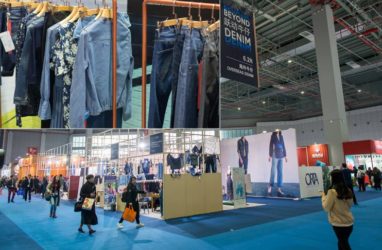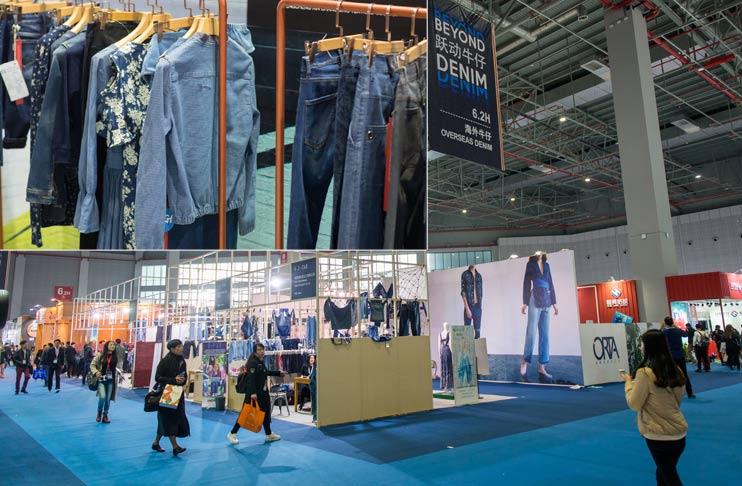‘Future Knitwear’ by Shima Seiki makes first appearance at Intertextile Shanghai. Exhibitors in expanded Beyond Denim show future of eco-friendly denim production.
With the pace of change in the textile industry seeming to increase at an ever faster rate, it’s becoming more and more important to stay ahead of the curve. Buyers looking for the latest innovations and technology will be well provided for this October (11-13), as Intertextile Shanghai Apparel Fabrics plays host to some of the industry’s leading innovators such as DuPont, Eastman Chemical, FENC, Hyosung, INVISTA, Lenzing, Nilit, The Chemours Company, Toray and Unifi, not to mention the hundreds of smaller companies from Mainland China, Korea, Taiwan and elsewhere that are pushing the boundaries of what’s possible with apparel fibres and fabrics.
Besides these exhibitors, for the first time Intertextile Shanghai will also play host to one of the industry’s true heavyweights in terms of innovation: Japan’s Shima Seiki. With over 2,000 worldwide patents and patents pending, and 30 years of research experience in knitting technology, this computerised knitting machine manufacturer will exhibit at the fair alongside a number of its partners including yarn suppliers and knitwear manufacturers, providing a one-stop knitwear solution under the theme ‘Future Knitwear’.
Shima Seiki is well known for its WHOLEGARMENT® manufacturing technology – where an entire knitted garment is produced on the knitting machine without the need for linking or sewing afterward – but it will be its SDS-ONE APEX3 3D design system, the latest version of which will be on display at Intertextile Shanghai, which makes this theme highly appropriate. This system integrates production into one workflow, from yarn development, product planning and design to production and even sales promotion. One key feature is its Virtual Sampling function, which improves the design and evaluation process, and minimises the time, cost and material usage during the sample-making process. The overall effect of this system can be to shorten the production cycle to such an extent that mass-customisation of garments can be achieved.
Intertextile Shanghai Exhibitors in expanded Beyond Denim show future of eco-friendly denim production
Within the denim sector, not only are consumers’ changing tastes driving innovations in denim wear technologies and styles, but their increased awareness of the environmental impact of jeans production is moving producers to innovate in terms of production too. A number of exhibitors within this edition’s Beyond Denim will be showcasing their proprietary efforts to drive the industry towards a more eco-friendly future, including Turkey’s Orta Anadolu and Kipas Denim, and Soorty Enterprises from Pakistan. The larger Beyond Denim this year will include around 190 overseas and Chinese exhibitors, as well as an INVISTA Pavilion and Forum highlighting exhibitors’ products.
Jeans Matter by Orta Anadolu

Orta Anadolu will showcase its AW 18/19 collection under the theme Jeans Matter. “Denim has and always will have a special handprint on culture. In times of social change, Jeans Matter,” is how the company explains the theme, which includes the concepts Feel Matters, Colour Matters, Style Matters – with two trend ‘tribes’ Remakers and Wanderset – and Process Matters.
Within Process Matters, Orta has launched a new concept it calls Indigo Flow which combines the Reserve Flow and Clean Flow processes for a more eco-friendly indigo dyeing process. Reserve Flow can reduce water usage by up to 70% through savings at the water feeding and finishing stages, while energy is saved by not requiring heat during the fixing process. This process can be applied to different types of indigo and sulphur dyeing. The Clean Flow process is unique to Orta as it utilises an organic reducing agent which leads to cleaner waste water, no salt formation and less chemical usage. This results in 60% less BOD (biological oxygen demand) and COD (chemical oxygen demand).
Conservablue by Kipas Denim
While progress has been made at the raw fibre stage to make denim more eco-friendly – think organic & recycled cotton and Tencel/cotton blends – and at the treatment and finishing stages with laser and ozone technology and new-generation enzymes, there is still some way to go at the fabric production stage.
Like Orta, Kipas Denim has developed their own technology to address the shortcomings during denim fabric production. This technology they brand as Conservablue, which aims to reduce the environmental impact of the dyeing process. Conventionally made jeans pass through six rinsing overflow boxes before and after the indigo dye boxes, which Conservablue eliminates altogether leading to water, waste water, electricity and dyestuff savings. Furthermore, in the normal dyeing process as much as 5% of dyestuff washes off in the rinsing baths, but Conservablue ensures 100% of the applied dyestuff remains on the yarn.
Zero Water Blue by Soorty Enterprises
As with Kipas Denim, Soorty Enterprises emphasises their eco-friendly efforts along the entire production chain, from cotton sourcing to finishing. Their new Zero Water Blue concept promises water savings of up to 90% by eliminating water usage at the rope dyeing stage, and reducing it at the finishing stage by merging the traditional de-sizing and mercerisation steps into one ‘relaxing’ step. This new step, along with eliminating water usage at the final sanforisation stage, not only saves water overall but also eliminates caustic and acid use during this stage as well. At the washing stage, the use of laser and ozone treatments reduce water, chemicals and electricity by up to 95%, 50% and 79%, respectively.


